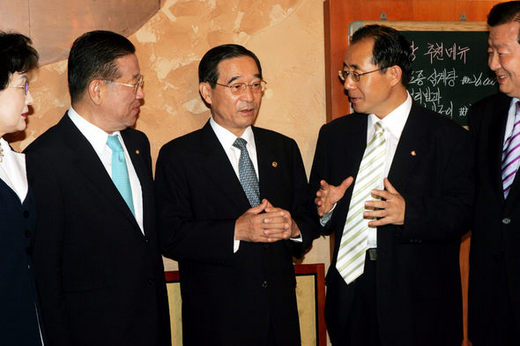Posted on : Aug.17,2006 21:30 KST
Modified on : Aug.18,2006 14:36 KST
 |
|
Defense Minister Yoon Gwang-ung (center) talks to representatives of the ruling Uri Party on August 16.
|
South Korea and the United States will establish a headquarters for cooperative military operations, a key step toward a proposed joint defense system, when South Korea regains wartime control of its military, Seoul's top defense official said Thursday.
The headquarters tentatively called the Military Cooperation Center, which will replace the existing Combined Forces Command (CFC), will come under joint control of two-star generals from Seoul and Washington and consist of some 10 standing and non-standing organizations, Defense Minister Yoon Kwang-ung said in a report to a parliamentary committee of national defense. The CFC was created in November 1978 and took over wartime control rights from the American-led United Nations Command (UNC).
The two commands are both under the control of the top U.S. commander here, a four-star general.
Seoul and Washington have agreed to maintain the U.S.-led UNC on the Korean Peninsula despite the planned dismantlement of the CFC. They are to create two separate commands before establishing a joint defense system.
"Joint chairmen from the two sides will run the center, and the overall control and command of the cooperative system will be in the hands of South Korea's chairman of the Joint Chiefs of Staff," Yoon told the committee when asked about the nature of the headquarters' function.
In comparison, Yoon explained that the two commands now living under the same roof will be divided into two separate ones but that they will maintain close cooperative ties.
On the question of whether the headquarters will be able to make strategic orders, Yoon said he believes it will give orders on cooperation. According to the report, a shift to a new system led by South Korea and supported by the U.S. is contained in a draft road map for regaining wartime control. Under the joint defense system, South Korea's Joint Chiefs of Staff will act as theater command on the Korean Peninsula, while the U.S. Forces Korea will provide support.
The headquarters will address joint military operations during times of peace and war, and it will be designed to be stronger than the U.S.-Japan alliance model, defense ministry officials said.
South Korea and the U.S. are in the final stage of completing joint studies on the terms of a new alliance, with a focus on Seoul's greater role in its military operations. But they are still at odds over the timeline of and roadmap for the transfer of wartime operational control.
The U.S. suggested it can transfer wartime operational control of troops to South Korea as early as 2009, citing its improved defense capabilities, while South Korea hopes to retake independent wartime control by 2012.
The final results will be unveiled at an annual gathering of South Korean and U.S. defense ministers in Washington in October.
South Korea voluntarily put the operational control of its military under the UNC shortly after the Korean War broke out in 1950. It regained peacetime control of its forces in 1994, but wartime operational control remains in the hands of the top U.S. commander here.
According to the report, Seoul and Washington will continue to operate high-level military channels such as the annual defense chiefs' Security Consultative Meeting (SCM) and joint chiefs of staff chairmen's Military Committee (MC), even after Seoul assumes wartime operational control of its troops and the two sides run separate commands here.
Meanwhile, President Roh Moo-hyun dismissed calls for a referendum on taking back the wartime control, which irks conservative forces in South Korea worried about the possible departure of U.S. troops stationed here.
"It is not a matter of referendum," Roh said in a meeting with ruling party members of the National Assembly's National Defense Committee, according to participants in the meeting.
The presidential office Cheong Wa Dae holds a position that wartime control retrieval is not an issue to be put on a referendum because it is not deemed to have an impact on or pose a threat to national security.
But the main opposition Grand National Party counters that it is a serious enough security matter to warrant a referendum, saying it will weaken the long-running alliance between Seoul and Washington and cause a misguided attempt by North Korea to attack South Korea.
Currently, about 30,000 U.S. troops are stationed in South Korea, a legacy of the 1950-53 Korean War. The U.S. plans to cut the number of its troops here to 25,000 by 2008.
The two Koreas are still technically in a state of war, since the Korean War ended in an armistice rather than a peace treaty.
The Seoul-Washington alliance, forged in blood during the Korean War, has faced fundamental changes in recent years, as South Korea demands a greater role in its military operations to reduce its 680,000-strong military's dependence on the U.S. armed forces.
The U.S., for its part, has also begun transforming its fixed military bases in South Korea into more mobile, streamlined forces as part of its global troop-realignment plan.
Seoul, Aug. 17 (Yonhap News)



